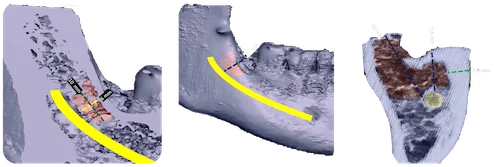 When it comes to our health, what we don’t see can sometimes matter the most. In dentistry, traditional 2D X-rays of the jaws (called panoramic X-rays) often miss critical details—hidden infections as well as structural concerns that can affect not just the mouth, but the health of the entire body.
When it comes to our health, what we don’t see can sometimes matter the most. In dentistry, traditional 2D X-rays of the jaws (called panoramic X-rays) often miss critical details—hidden infections as well as structural concerns that can affect not just the mouth, but the health of the entire body.
Many years ago, 3D CBCT scans became available in dentistry and have proven valuable due to their low level of exposure and their ability to capture abnormalities from the base of the neck to the eye sockets. Because of this, dentistry has been able to diagnose a multitude of otherwise hidden but significant sources of disease. With this sophisticated 3-D scan technology, biological dental surgeons use advanced treatment protocols to remedy the concerns they find.
However, dentists and dental radiologists have been challenged with properly diagnosing these unusual infections within the jawbone because of limitations in traditional 3D CBCT software. That’s where Visiogenics comes in. Recently launched, Visiogenics is a highly advanced tool developed under Prof. Shahram Ghanaati, MD, DMD, PhD’s leadership. This tool allows dental surgeons to identify with precision any areas of infection or abnormal bone healing in the jaw, enabling them to provide truly biological treatment protocols. Prof. Shahram Ghanaati is one of the leading figures and scientifically published researchers in the advanced concepts of regenerative biological oral and maxillofacial surgery.
Why 3D Visualization Matters
 Because of the challenges in proper healing, abnormal bone is often found in areas of previous extractions and in sites where root canals have been performed. These areas, commonly known as “cavitations,” are medically referred to as FDOJ (fatty degenerative osteonecrosis of the jaw) or IBD (ischemic bone disease). They are often filled with aggressive bacteria, viruses, parasites, and fungi that thrive in dark, moist environments. Due to the highly vascular tissue in the oral cavity, these organisms can invade the bloodstream. Research has associated these chronic oral infections to a wide range of health concerns, including cardiovascular disease, brain dysfunction, Alzheimer’s disease, dementia, cancers, and respiratory illnesses.
Because of the challenges in proper healing, abnormal bone is often found in areas of previous extractions and in sites where root canals have been performed. These areas, commonly known as “cavitations,” are medically referred to as FDOJ (fatty degenerative osteonecrosis of the jaw) or IBD (ischemic bone disease). They are often filled with aggressive bacteria, viruses, parasites, and fungi that thrive in dark, moist environments. Due to the highly vascular tissue in the oral cavity, these organisms can invade the bloodstream. Research has associated these chronic oral infections to a wide range of health concerns, including cardiovascular disease, brain dysfunction, Alzheimer’s disease, dementia, cancers, and respiratory illnesses.
The problem is that cavitations are difficult to interpret on traditional 3D CBCT scans, leading to confusion or misdiagnosis among practitioners. Visiogenics was designed to solve this problem. This advanced software gives doctors the ability to see the jaw, teeth, and sinuses in precise three-dimensional detail and, most importantly, provides clarity on the biologic state of bone healing.
For patients, this means:
- Finding what’s been missed: Cavitations and unhealed bone areas invisible on standard scans can now be identified with precision.
- Connecting the dots: For those with unexplained symptoms like fatigue, immune dysfunction, or chronic inflammation, advanced dental imaging may help reveal hidden oral contributors.
- Planning with precision: For patients preparing for treatment, these scans create a surgical “roadmap,” helping doctors address immediate concerns and treat the underlying biology that supports long-term health.
A Human-Centered Approach
One of the most important features of Visiogenics is that it is not simply machine-generated imaging. Each case is reviewed by a multidisciplinary team led by Prof. Ghanaati, with radiologists, surgeons, and engineers, ensuring biologically sound conclusions.
Whole-Body Health, Rooted in the Mouth
Science continues to confirm what holistic and biological dentistry has long recognized: the health of the mouth and the health of the body are deeply connected. Chronic oral infections, even when painless or invisible, can strain the immune system and increase inflammation throughout the body, undermining overall wellness.
With Visiogenics, dentists trained in biological surgery are able to detect these burdens and intervene appropriately. A very limited number of biological dentists in the United States have undergone the intensive study required to use Visiogenics diagnostics and to perform the highly skilled biological surgeries used to remediate these problems. These practitioners have pursued the Biological Oral Surgery Maxi-Residency certification at Tufts University School of Dentistry, under the instruction of Prof. Shahram Ghanaati himself.
What to Expect
For patients, the process is straightforward:
- 1. Scan: A comfortable, non-invasive 3-D CBCT scan creates a 3D image of the teeth, jaws, joints, sinuses, and airway.
- 2. Expert review: The scan is analyzed by a specialized team under Prof. Shahram Ghanaati’s leadership.
- 3. Biological surgical map: A precise and detailed visualization and treatment roadmap is created.
- 4. Consultation: You and your dental provider review the findings together and discuss next steps.
The result is not just a clearer picture of oral health, but a more confident path toward long-term healing and overall wellness.
Looking Ahead
As dentistry advances, tools like Visiogenics represent a profound shift. They allow us to better honor the complexity of the human body while giving practitioners the insight to support the body’s natural healing ability. For patients, this means more than improved dental outcomes—it means renewed energy, vitality, and total health that radiates far beyond the smile.
Ghanaati, S. (2024). Visiogenics: 3D CBCT visualization software for identifying cavitations and abnormal bone healing in the jaw. Ghanaati Education Platform. Retrieved from https://www.ghanaati-education.com/about